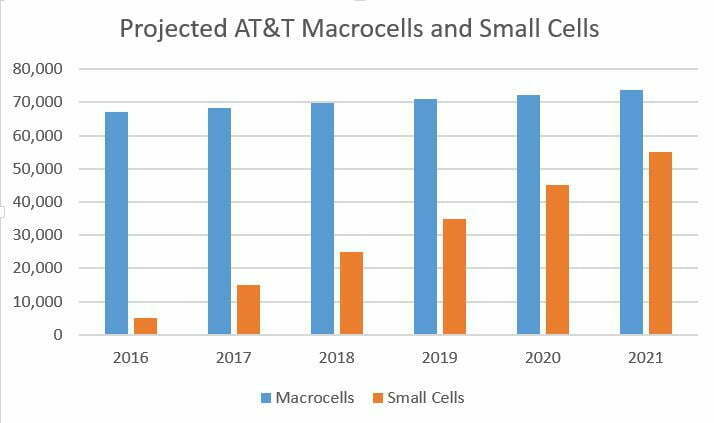AT&T Forecasts 6,700 New Macrocells from 2017-2022
In a presentation at the Cohen and Company’s 44th Annual Technology, Media, and Telecom conference, AT&T’s CTO and President of AT&T Labs Krish Prabhu indicated that AT&T believes that small cells will make up the substantial majority of their future cell tower and cell site development over the next 5 years. In response to a question on how small cells will fit into their future 5G, fixed wireless, and IOT networks, Prabhu indicates that AT&T has approximately 90% of their macrocell network that they expect to be in place in the next five years already standing. However, they have only deployed 5-10% of the total count of small cells that they expect to have at 2022.
Based upon our best information, AT&T currently has approximately 67,000 macrocell sites in the United States. Assuming 10% growth, that means that AT&T will deploy approximately 6,700 new macrocells over the next 5 years. We are unsure of the total count of small cells owned by AT&T in the US, but would estimate that number at 5,000 or less. (If anyone has better numbers, please comment below). If 5,000 represents 10% of their projected small cell builds, we would expect to see 50,000 new small cells over the next 5 year period. Below is a chart showing a straight line estimate of new AT&T macrocells and small cells based upon 6,700 new macrocells and 50,000 new small cells over 5 years.

Projected AT&T Small Cell and Macrocell Growth- 2017-2022
A word of caution: AT&T previously indicated that they would be building 40,000 AT&T small cells which never actually occurred. In this case, though, we believe that AT&T is likely to build a significant number of small cells and should exceed the 40,000 previously anticipated. As Prabhu indicates in the discussion, 5G wireless in the millimeter wave bands “gets really bad once you go several 100 meters”. There are only so many towers and the cost of adding new macrocells is significantly more expensive than adding new small cells.
By way of comparison, AT&T has completed just over 10,000 new macrocells over the last 5 years based upon information provided by RBC Capital Markets.












7 thoughts on “AT&T Forecasts 6,700 New Macrocells from 2017-2022”
How is small cell defined in this article?
In this context, I suspect that AT&T is referring to small cells as individual standalone picocell, metrocell, or microcells but would not include femtocells. I anticipate that this includes both indoor and outdoor small cells- but I would welcome any other thoughts that readers might have.
Will smaller cell towers push more signals there are places where calls get dropped not just at&t but other carriers as well
How can I determine if AT&T is constructing a future cell sight on my street South Gaines in Little Rock? there is a Flag indicating future construction in the easement . Is it a box or tower?
The best way is to contact your City planning department and inquire on whether there is a new tower being constructed.
“Small cells”, more appropriately named, “close proximity microwave transmitters”, will have true 5G technology (24-90 GHz) transmitters approximately every 500 feet, EVERYWHERE in the target community. Here it comes. Everyone will live near a cell tower and be radiated 24/365, inescapably, without consent…Unless we #STOP5G in our communities and around the world.
Sharon, without getting into the question of whether small cells are safe or not, I would clarify two things. First, not all small cells are “microwave transmitters”. Nor is “true” 5G just 24-90GHz. Many small cells are sub-6Ghz spectrum using traditional cellular frequencies. “True” 5G will also use tower based antennas. Secondly, not that it makes it better, but in some areas, small cells are being deployed every 200 ft by each carrier.